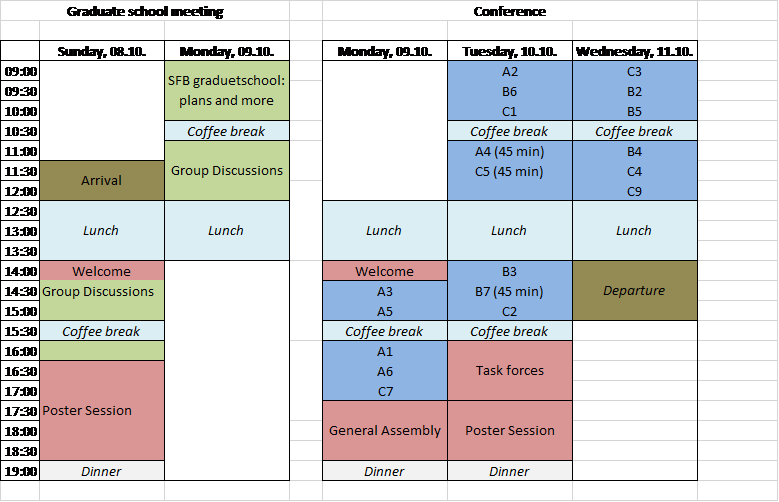SFB Conference in Hohwacht 2017
The SFB Workshop 2017 in Hohwacht split into two parts, the summer school for the PhD Students and the Conference for all members of the SFB 925. One of the main goals for this year SFB Workshop was to catalyse further cooperation within the SFB. This led to the decision to reorganize the summer school to cultivate cooperation on the young researcher's level.

As in the past years, the young researcher’s of the SFB organized the Summer School of the SFB 925. Over the past SFB Workshops, we have learned the most fruitful discussions arise in small groups and if the groups have sufficient discussion time. This convinced us, to break with the "few big talks for all" scheme and create something new. First, we split the 18 students into four groups with mixed members from all areas. Second, we chose to have shorter and fewer presentations and therefore more time to discuss.
|
Group A |
Group B |
Group C |
Group D |
|
Ultrafast quenching of magnetization Matthias Riepp, Project B3
Molecular dissociation dynamics Oliver Schepp,
Molecules in solvents/solutions Henning Kirchberg, Project A4 Quantum Gases in optical (driven) latices/traps |
Quantum gas microscopes for cold atoms Photoelectron-photoion coincidence spectroscopy
X-ray parametetric down conversion Christina Boemer, Project A4 High orbital physics in cold atom lattices Max Hachmann, Project C2 |
Common expressions in ultracold atom experiments Short Introduction into Experiments with BEC in High Finess Cavitys Non-adiabatic dynamics Light-field-driven streak camera Katharina Wenig, Project A1 Time-dependent metal-insulator transition with light-induced dynamics Patryk Kubiczek, Project B4 |
Physics in the second band of an optical lattice
Synthetic gauge field studies of Ytterbium atoms
Tracking chemical reactions with time-resolved sulfur-1s absorption spectroscopy Controlling the electronic structure of graphene with light Razvan Krause, Project B6 Exploring bound electron triples and trimes in solid state physics |
Every student had to prepare a 10min talk about his or her work. The student could freely choose the presentation content and style, which led to a wider spectrum of topics to discuss. After teach talk, the group had 20min to ask questions and discuss similarities or differences between the personal projects and the talk. After the talks, we gave the groups additional time to collect and again discuss the similarities within the group. These results have then been collected in a short presentation session with all students.
While the talk scheme was changed, one very successful format was the PhD poster presentation. Even though there is a poster presentation at the Conference where every project presents the latest results, we hold a special poster presentation just for the students with the same poster as on the Conference. Here the students used the opportunity to discuss their work and many more topics from new ideas to technical details of similar projects. Those discussions were not limited to the poster session and have been pursued over the next couple of days.
Following the summer school, the SFB conference took place. Within two days, every project had time to present the latest results and communicate new ideas. For this, every project had a presentation in front of all SFB members and additionally, a poster session for further discussions took place. The third component of our conference is the joint task force session. Here we have the possibility to discuss many hot topics, some of them not directly related to our own research. In the format of small group discussions, we discuss the topics and getting the insight of the other projects and areas on these topics. Because of our goal, to drive more cooperation within the SFB, we chose to not invite any guest.
